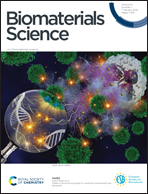A novel anti-tumor/anti-tumor-associated fibroblast/anti-mPEG tri-specific antibody to maximize the efficacy of mPEGylated nanomedicines against fibroblast-rich solid tumor†
Abstract
The therapeutic efficacy of methoxypolyethylene glycol (mPEG)-coated nanomedicines in solid tumor treatment is hindered by tumor-associated fibroblasts (TAFs), which promote tumor progression and form physical barriers. We developed an anti-HER2/anti-FAP/anti-mPEG tri-specific antibody (TsAb) for one-step conversion of mPEG-coated liposomal doxorubicin (Lipo-Dox) to immunoliposomes, which simultaneously target HER2+ breast cancer cells and FAP+ TAFs. The non-covalent modification did not adversely alter the physical characteristics and stability of Lipo-Dox. The TsAb-Lipo-Dox exhibited specific targeting and enhanced cytotoxicity against mono- and co-cultured HER2+ breast cancer cells and FAP+ TAFs, compared to bi-specific antibody (BsAb) modified or unmodified Lipo-Dox. An in vivo model of human breast tumor containing TAFs also revealed the improved tumor accumulation and therapeutic efficacy of TsAb-modified mPEGylated liposomes without signs of toxicity. Our data indicate that arming clinical mPEGylated nanomedicines with the TsAb is a feasible and applicable approach for overcoming the difficulties caused by TAFs in solid tumor treatment.



 Please wait while we load your content...
Please wait while we load your content...